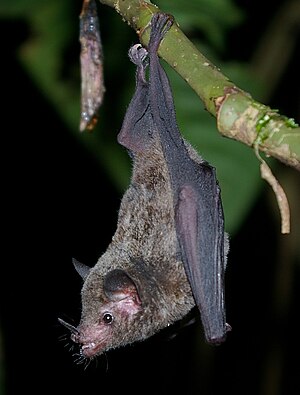Glossophaga
| Glossophaga | ||||||||||||
|---|---|---|---|---|---|---|---|---|---|---|---|---|

|
||||||||||||
| Systematics | ||||||||||||
|
||||||||||||
| Scientific name | ||||||||||||
| Glossophaga | ||||||||||||
| É. Geoffroy , 1818 |
Glossophaga is a genus of bats in the subfamily of the flower bats (Glossophaginae). The five species occur in Central and South America .
features
With a head-trunk length of 48 to 65 mm, a tail length of about 7 mm and a forearm length of 32 to 42 mm, the species are among the smaller flower bats. The weight is around 10 g. The coat color varies between dark brown, reddish brown and light brown. Like the other blossom bats, the Glossophaga species have a long snout with a pointed nasal blade , a noticeably long tongue with brush-like papillae at the tip and elongated, narrow molars.
Types and distribution
There are five types:
- Commissaris flower bat ( Glossophaga commissarisi ), from Mexico to Peru and the Guyana region .
- Gray-flowered bat ( Glossophaga leachii ), from Mexico to Costa Rica .
- Miller-flowered bat ( Glossophaga longirostris ), lives in Colombia , Venezuela , Guyana Region.
- Western flower bat ( Glossophaga morenoi ), in western and southern Mexico.
- Common flower bat or shrew long-beak ( Glossophaga soricina ), from Mexico to Argentina .
Way of life
These bats have adapted to a range of habitats . They occur in dry forests or bushes with deciduous plants, but can also be found in moist, evergreen forests. The species live in the lowlands and in mountains up to 2,600 meters above sea level. Mostly they follow streams or rivers in search of food.
Both natural hiding places such as caves, crevices and cavities in trees and artificial objects such as buildings, tunnels, mining shafts or culverts serve as resting places. In hiding these bats often form smaller groups, and large colonies of up to 1000 specimens are also known. In some populations, the large colonies consist only of females and their offspring.
The Glossophaga species eat nectar , pollen , fruits, flowers and insects. Often the individuals are alone in foraging for food and some specimens defend preferred plants against conspecifics. They can float in front of flowering as they sip nectar.
In the species there are several litters per year, which are usually linked to times of abundance of food. Females are two to three months pregnant and usually give birth to one young per litter, rarely twins. In the case of Glossophaga soricina , the young animal clings to its mother's coat for the first few days. After 25 to 28 days it can fly on its own. One specimen lived in human care for 10 years.
swell
- Ronald M. Nowak: Glossophaga Walker's Mammals of the World. Volume 1. pp. 368-369, 6th edition. Johns Hopkins University Press, Baltimore MD et al. 1999, ISBN 0-8018-5789-9 .
- Don E. Wilson , DeeAnn M. Reeder (Eds.): Mammal Species of the World . A taxonomic and geographic Reference . 3. Edition. 2 volumes. Johns Hopkins University Press, Baltimore MD 2005, ISBN 0-8018-8221-4 (English, Glossophaga ).
- Glossophaga on the2015 IUCN Red List of Threatened Species. Retrieved November 14, 2015.
- Commissaris's long-tongued bat , Miller's long-tongued bat & Pallas's long-tongued bat on the University of Michigan Museum of Zoology's Animal Diversity Web.